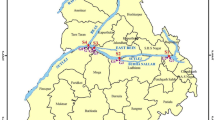Abstract
The quality of Ogun river in South-West, Nigeria was studied by a field survey for a period of 1 year (covering dry season and rainy season). Water samples were collected from thirteen sites and analysed for physico-chemical and bacteriological parameters as well as heavy metals using standard methods. Generally, the values obtained for turbidity, phosphate, oil and grease, iron and faecal coliform from all the sites in both seasons were above the maximum acceptable limit set by the World Health Organization (WHO) for drinking water. Also, the manganese content from all the sites in the dry season, lead concentrations from three sites in the dry season and cadmium concentrations from some sites in both seasons were above the WHO limit. The values obtained for total dissolved solids, dissolved oxygen and chloride at site M in the dry season and nitrate at site J in the rainy season were also above the WHO limit. Pollution of Ogun river water along its course is evidenced by the high concentrations of pollution indicators, nutrients and trace metals above the acceptable limit. This poses a health risk to several rural communities who rely on the river primarily as their source of domestic water. The study showed a need for continuous pollution monitoring programme of surface waters in Nigeria.
Similar content being viewed by others
References
Adetunji, M. T. (1994). Nitrogen application and underground water contamination in some agricultural soils of South Western Nigeria. Fertilizer Research, 87, 159–163.
Ahonkhai, S. I., & Chukwuogo, E. I. (1996). Effects of industrial activities in Warri area on the surface water quality. Environmental Monitoring and Assessment, 16, 259–264.
Aina, E. O. A., & Adedipe, N. O. (Eds.) (1996). Water Quality Monitoring and Environmental Status in Nigeria (p. 239). FEPA Monograph 6, FEPA, Abuja, Nigeria.
APHA (American Public Health Association) (1998). Standard methods for the examination of water and wastewater, APHA, 20th Ed., Washington, DC 4–67, 4–144, 5–99, 9–54.
Calamari, D., & Naeve, H. (1987). Water quality problems in Africa: A brief report. International Journal of Environmental Studies, 29, 3–8.
Calamari, D., & Naeve, H. (Eds.) (1994). Review of pollution in the African aquatic environment. CIFA Technical Paper No. 25, FAO, Rome, 118 pp.
Chudaeva, V. A. (1988). Distribution of certain metals in river run-off in various region of the Far East. Journal of Water Resources, 6, 86–95.
Correll, D. L. (1998). The role of phosphorus and euthrophication of receiving waters. A review. Journal of Environmental Quality, 27, 261–266.
Fatoki, O. S., Muyima, N. Y. O., & Lujiza, N. (2001). Situation analysis of water quality in the Umtata river catchment. Water S.A., 27, 467–473.
Federal Republic of Nigeria (FRN) (2000). National water supply and sanitation policy (1st edn.). Federal Ministry of Water Resources, Abuja, Nigeria.
GESAMP (1991). The state of the marine environment, Joint group of experts on the scientific aspects of marine pollution, Oxford Blackwell Scientific Publ. pp. 5, 41–45, 71.
Ichikawa, H. (1990). Microbiological indicators for evaluating treatability on water purification process. Japanese Journal of Water Pollution Research, 13, 477–484.
Jideani, I. A. O. (1996). Bacteriological quality of water sources at the University in Bauchi and neighbouring community. In E. O. A. Aina, & N. O. Adedipe (Eds.). Water quality monitoring and environmental status in Nigeria (pp. 208–215). FEPA Monograph 6, Abuja, Nigeria.
Lloyd, B., & Helmer, R. (1992). Surveillance of drinking water quality in rural areas (pp.34–56). Longman Scientific and Technical. New York: Wiley.
Martins, O. (1987). The Ogun River: Geochemical characteristics of a small drainage basin. Hydrological Processes, 64, 475–482.
Martins, O., & Awokola, O. S. (1996). Total dissolved solids of selected rivers in South-Western Nigeria. Journal of Mining and Geology, 32(2), 113–119.
Mathuthu, A. S., Zaranyika, F. M., & Jonnalagadda, S. B. (1993). Monitoring of water quality in Upper Mukuvisi River in Harare, Zimbabwe. Environment International, 19, 51–61.
Mok, W. M., & Wai, C. M. (1990). Distribution and mobilization of trace metals in the Coeur d’alene River, Idaho. Environmental Science and Technology, 24, 102–108.
Morokov, V. V. (1987). Assessment of river pollutant source. Journal of Water Resources, 14, 1027–1041.
Obire, O., Tamuno, D. C., & Wemedo, S. A. (2003). Physico-chemical quality of Elechi creek in Port Harcourt, Nigeria. Journal of Applied Science & Environmental Management, 7, 43–49.
Olajire, A. A., & Imeokparia, F. E. (2001). Water quality assessment of Osun river: Studies on inorganic nutrients. Environmental Monitoring and Assessment, 69, 17–28.
Osibanjo, O. (1996). Present water quality status in Nigeria. In E. O. A. Aina, & N. O. Adedipe (Eds.). Water quality monitoring and environmental status in Nigeria (pp. 35–59). FEPA Monograph 6, Abuja, Nigeria.
Rapin, F., Blanc, P., & Corvi, C. (1989). Eutrophication trends in the water quality of the Rhode river. Journal of the Marine Biological Association, 54, 825–855.
UNEP (United Nations Enviroment Programme) (1991a). Earthwatch – Global Enviroment Monitoring System. WHO/UNEP Report on Water Quality. 79 pp.
UNEP (United Nations Environment Programme) (1991b). FreshwaterPollution. Nairobi, UNEP/GEMS Environment Library, 35 pp.
UNEP (United Nations Environment Programme) (1993). Environmental Data Report (93/94). Blackwell, Oxford, UK, pp. 63–105.
Vernon, F., & Wani, C. D. (1993). Preconcentration methods for determination of copper, cadmium, lead and zinc in surface waters: A comparative study. Analytical Proceedings, 30, 442–445.
WHO (World Health Organization) (1984). Guidelines for drinking – Water quality, Vol.1: Recommendations. WHO, Geneva. 130 p.
Author information
Authors and Affiliations
Corresponding author
Rights and permissions
About this article
Cite this article
Jaji, M.O., Bamgbose, O., Odukoya, O.O. et al. Water quality assessment of Ogun river, South West Nigeria. Environ Monit Assess 133, 473–482 (2007). https://doi.org/10.1007/s10661-006-9602-1
Received:
Accepted:
Published:
Issue Date:
DOI: https://doi.org/10.1007/s10661-006-9602-1




